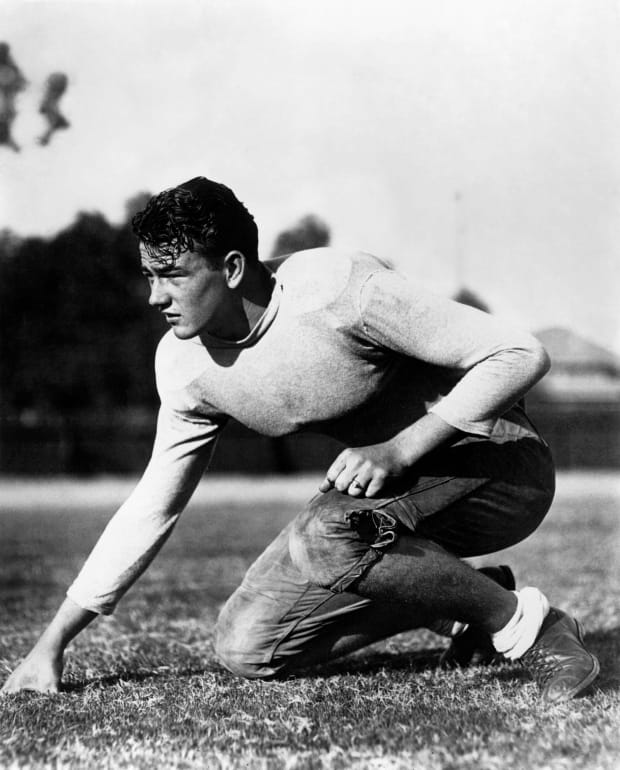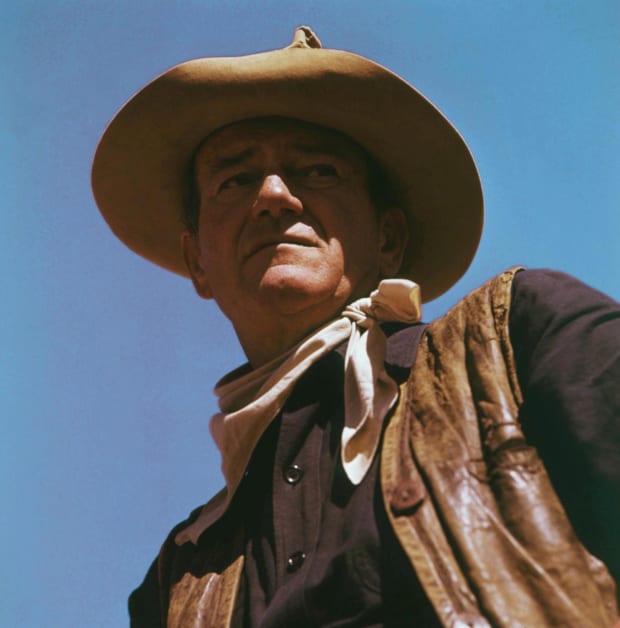Considering the spectacle that the NFL draft has become over its 86-year history, the 2022 version in Las Vegas represents a consummate marriage of subject and city. Top prospects are strutting across a red-carpet platform built atop the Bellagio fountain. A pop-up plaza in the spinning shadow of the High Roller Ferris wheel is hosting what the Las Vegas Review-Journal described as “the largest draft theater area” ever. Half a million fans are projected to attend, while three days of road closures reportedly mark the “longest traffic shutdown of the Strip to date.”
All told, the gaudy scene is a far cry from what the draft used to be—which is to say, pretty long and pretty boring for everyone involved. The first televised draft, on ESPN in 1980, paved the way for the current era of year-round mock drafts, prime-time broadcasts and custom-tailored suits. But as former NFL coach Weeb Ewbank once told the Los Angeles Times, “In the old days, when there were 30 rounds, you’d see some pretty strange picks. We’d get to the 20th round and guys would start looking through the football magazines for names to pick.”
What began in 1943 to counteract the inevitability that many eligible players would be called into combat service instead, the now-unfathomable 30-round draft dragged on as the standard through the end of the ’50s. “Whom didn’t they draft?” Tony Kornheiser later wrote in The Washington Post. “Dame Margot Fonteyn?” But even a subsequent return to the pre–World War II norm of 20 did little to lessen the humdrum task that was picking in deeper rounds.
No shortage of anecdotes reflect what the Miami Herald dubbed this antiquated, pre-Hollywood-ization period, with player names “chalked on a blackboard—often illegibly” and pick time “kept by a small, hand-wound watch.” And so it’s ironic (or maybe prophetic) that the most emblematic one from this forgotten genre features a cast of characters straight out of a script: a football coach with a Hollywood background; a Hollywood icon with a football background; and a college running back who went nearly 50 years before discovering that he was involved at all.
Held at the Belmont Plaza hotel on the southern tip of Central Park, the 1971 NFL draft is best remembered for being the original “Year of the Quarterback.” Jim Plunkett (No. 1), Archie Manning (No. 2) and Joe Thiesmann (No. 99) headlined a heralded class of six signal-callers who went in the top 100. Much less known is what happened the following day, when a league official announced in the 17th and final round: “Atlanta takes tackle John Wayne of Apache U.”
According to the Associated Press, a Falcons representative on site framed the selection as “a big, strong guy who has also had some success in a couple of movie roles.” As the famed actor was 63 at the time—and more than two decades removed from his 1948 appearance alongside Henry Fonda in “Fort Apache”—the obvious “phantom selection” came across as the Falcons “play[ing] it for laughs” and received little more than “tired titters from the gallery.”
But at least two people were fooled. One was an unidentified Georgia Tech fan who groused to a reporter, “I think that it’s a pretty sick joke when they select John Wayne and leave Rock sitting there,” referring to the Yellow Jackets’ all-American defensive tackle Rock Perdoni. The other was the gullible soul overseeing the board of picks, as Wayne’s name was “duly posted” there before being “exposed as a fraud” and disallowed by commissioner Pete Rozelle.

Kobal/Shutterstock
Sexagenarian status aside, Wayne was not a bad subject for such a lark. Born Marion Robert Morrison, the native Iowan had picked up football from an early age thanks to his father, a former college player, later earning a scholarship to Southern California as a 170-pound offensive lineman. It was while on campus that Morrison also got his start in show business, first hauling set props as a part-time gig at nearby Fox Film Corp., then making on-screen cameos as football players in Brown of Harvard (1926) and Drop Kick (’27).
A broken collarbone, suffered while surfing before his junior season, put a premature end to Morrison’s modest run as a football player and paved the way for his eventual transformation into the biggest Western film star ever. But he forgot neither his roots in the game nor what it had taught him, taking a role as a washed-up coach in Trouble Along the Way (1953) and later telling United Press International, “Football put me on that stage coach and sent me on my way. I found out early in life that football gave me an unusual understanding of the other fellow. You don’t care what color or religion he is, or what he thinks, but if he hits you hard, he gets your attention and usually your respect.”
Perhaps it was a similar mix of passions—football and film—that inspired Falcons coach Norm Van Brocklin to reportedly bark to his staff at the Belmont before attempting to pick Wayne, “Do we want the roughest, toughest S.O.B. in the draft?” A former quarterback, Van Brocklin had himself appeared as football players in two Hollywood movies—Crazylegs (1953) and The Long Gray Line (’55)—while playing for the Los Angeles Rams. And when he died in ’83, at 57, among the mountain of memorabilia left behind was a Screen Actor’s Guild card, according to his daughter Karen Vanderyt. “How could he not love [Wayne]?” Vanderyt says.
No matter why Wayne was chosen in particular, there is no question that Van Brocklin had the sort of biting humor sense required to take aim at the draft’s plodding pace in such a public way. For an NFL Films video, former on-field official Tony Veteri recalled once spelling out his last name to Van Brocklin on the sidelines, to which the coach fired back, “I might’ve known you’ve only got one goddamn i.” Added the late back and line judge Art Holst in the same video, “As creative a man with foul language as anybody I’ve ever run into.”
For her part, Vanderyt had never heard the Wayne story, or her father’s involvement spearheading the stunt, until recently contacted by a Sports Illustrated reporter. Still, she says, “Dad was a master of one-liners. He had a quick wit. Of the things that’ve been printed about him, many are true, many are not. This sounds like one he probably did say.”
But even Van Brocklin eventually grew miffed at what he saw as an outsized response to an obvious throwaway crack made amid the bleariness of having sat through more than 400 picks—a response that brushed over the player whom the Falcons had gone on to actually select.
Bristled Van Brocklin to the Atlanta Constitution two months later, in March 1971, “It was a joke when we said, ‘John Wayne, tackle, Apache U.’ We drafted Willie Martin, a 222-pound running back from Johnson C. Smith, in the 17th round … not John Wayne.”
At the same time Van Brocklin was delivering the rootinest, tootinest draft speech of his coaching career, Willie Martin was squirreled away in his dorm room in Charlotte studying for a Spanish test. A few moments later, some of his classmates entered and told the senior running back that his name had been called in the NFL draft, 423rd. “I said, ‘Guys, don’t kid me with that,’” Martin recalls. “I put my jacket on, I started walking across campus, and another student goes, ‘Willie, congratulations, you got drafted by the Falcons!’”
Unconvinced, Martin continued on to his Spanish test, sitting through verbal and written portions and earning an A. “So I come out, I go to lunch and the dining room just erupts,” Martin says. “I went back to the dorm, and people wanted my autograph. I said no, because I didn’t know I was drafted or not.” Then an RA pointed Martin to the dorm phone and told him that some guy named Tom Braatz with the Falcons was on the line.
“I’ve heard this rumor,” Martin told him.
“Congratulations,” the team’s director of player personnel replied. “It’s official.”

Bernie Abramson/United Artists/Kobal/Shutterstock
Similar to Vanderyt, though, Martin didn’t know that he was technically Atlanta’s second choice that day until decades later. But he cops to being a big Wayne fan, having watched “a lot” of old Westerns with his father—also named John—as a kid. “I was impressed with the guy being so big and strong,” Martin says. “Man, I wish I had known [about the pick] back then.”
Other than what is in newspaper clippings, little more is known about the pick now. Multiple outlets have reported that an NFL Films crew captured the moment, but an NFL spokesperson tells SI that the entity has no record of shooting the 1971 draft. Vanderyt was initially hopeful of finding some primary-source material among her father’s papers, which include notes from other drafts, but a search came up empty. And a representative for John Wayne Enterprises says of the actor: “There is no indication in our archives that he knew about this joke.”
As often happens with such tales, the details have become less germane in retellings over time. In the mid 1980s the Hartford Courant listed Wayne’s supposed alma mater as Apache State; three years earlier the Miami Herald had it as Fort Apache State, and that Van Brocklin was helming the Vikings. Numerous sources have also falsely pegged the year as ’72.
But what started as a fleeting joke has forever impacted the man who filled Wayne’s saddle, even if he didn’t know about the connection until now. Then coming off a pair of strong, stock-boosting seasons for his historically Black university, Martin was ecstatic that his hard work had paid off with a selection. “Every day I dreamed about it,” he says. And he will never forget the confidence that Van Brocklin inadvertently instilled in him when he overheard the coach remark to an assistant on the walk back to the locker room after the Falcons’ third training camp practice, “That Martin guy from Johnson C. Smith, that’s a tough son of a bitch.”
Despite their differences, Martin draws parallels between himself and Wayne—beyond Van Brocklin’s use of profanity to describe them both. “I guess I do see a little bit of my toughness in him that he exemplified,” he says. “I was always a rough kid, wouldn’t mind mixing it up, and in high school [football] I was a fundamentally sound hitter. So when I heard about John Wayne, I laughed, because he was always in cowboy pictures, wrassling down calves.”
A sprained ankle ended Martin’s chances at lassoing a roster spot, as he was cut just before the regular season; later he latched on with a semi-pro team in Pittsburgh, lasting about six weeks before his ankle gave out again and he hung up his cleats for good. From there he returned to his hometown of Martinsville, Va., taking a job as an assistant principal while simultaneously completing his master’s in secondary school administration at Virginia, with the Falcons paying for his education as part of the rookie contract that he had negotiated.
Martin went on to spend 32 years at the chemical company DuPont, retiring as vice president of global operations in 2013. His departure was marked by six retirement parties, some at corporate headquarters and others at manufacturing facilities, each averaging more than 100 people a pop. Colleagues made speeches thanking him for his mentorship. Soul music was sung and grilled chicken was served, both personal favorites. “It was such a moving experience,” Martin says. And then, when his job was done, he walked off into the sunset.






